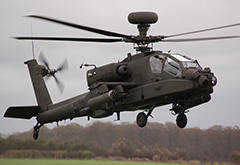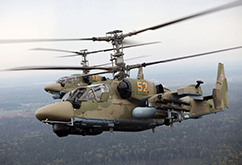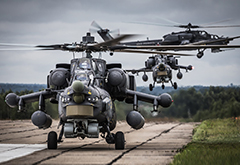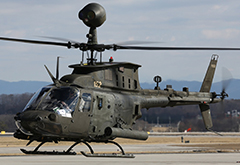1. Super Helicopters:
Since their breakthrough invention decades after the airplane, helicopters have been vital - used for surveillance, rescue and as a weapon of war. The latest super copters are one of an advanced breed of machines - built to fly fast and silently to places helicopters could never go before, even to the reaches of inner space. Incredible technology is making these super copters much more impervious to attack, with Kevlar and other advanced composite materials strengthening the body - while keeping it lightweight. The AgustaWestland AW101 (EH101) is a medium-lift helicopter used in both military and civil applications. More details
2. AH-64 Apache Helicopter:
The Boeing AH-64 Apache is an American twin-turboshaft attack helicopter with a tailwheel-type landing gear arrangement and a tandem cockpit for a two-man crew. It features a nose-mounted sensor suite for target acquisition and night vision systems. It is armed with a 30 mm (1.18 in) M230 chain gun carried between the main landing gear, under the aircraft's forward fuselage, and four hardpoints mounted on stub-wing pylons for carrying armament and stores, typically a mixture of AGM-114 Hellfire missiles and Hydra 70 rocket pods. The AH-64 has a large amount of systems redundancy to improve combat survivability. More details
3. Helicopters History:
4. Denel AH-2 Rooivalk:
5. Mil Mi-24 Hind Helicopter:
6. Bell AH-1 Cobra Helicopter:
7. Huey Helicopter:
8. Comanche Stealth Helicopter:
The Boeing–Sikorsky RAH-66 Comanche was a stealth armed reconnaissance and attack helicopter designed for the United States Army. Following decades of development, during 2004, the RAH-66 program was canceled prior to mass production commencing, by which point nearly US$7 billion had been already spent on the program. During the early 1980s, the U.S. Army started to formulate requirements for the replacement of its helicopters then in service, which resulted in the launch of the Light Helicopter Experimental (LHX) program. More details
9. Kamov KA-50/KA-52 Helicopter:
10. Eurocopter Tiger Helicopter:
The Airbus Helicopters Tiger, formerly known as the Eurocopter Tiger, is a four-bladed, twin-engined attack helicopter which first entered service in 2003. It is manufactured by Eurocopter (now Airbus Helicopters), the successor company to Aérospatiale's and DASA's respective helicopter divisions, which designate it as the EC665. In Germany it is known as the Tiger; in France and Spain it is called the Tigre. Development of the Eurocopter Tiger started during the Cold War, and it was initially intended as an anti-tank helicopter platform to be used against a Soviet ground invasion of Western Europe. More details
The Sikorsky CH-53E Super Stallion is the largest and heaviest helicopter in the United States military. As the Sikorsky S-80 it was developed from the CH-53 Sea Stallion, mainly by adding a third engine, adding a seventh blade to the main rotor and canting the tail rotor 20 degrees. It was built by Sikorsky Aircraft for the United States Marine Corps. The less common MH-53E Sea Dragon fills the United States Navy's need for long range minesweeping or Airborne Mine Countermeasures (AMCM) missions, and perform heavy-lift duties for the Navy. More details
12. W-3PL Głuszec Helicopter:
13. Russian Helicopters History:
14. Mil Mi-28 Attack Helicopter:
15. Black Hawk Helicopter:
16. CH-47 Chinook Helicopter:
The Boeing CH-47 Chinook is an American twin-engined, tandem rotor, heavy-lift helicopter developed by American rotorcraft company Vertol and manufactured by Boeing Vertol. The CH-47 is among the heaviest lifting Western helicopters. Its name, Chinook, is from the Native American Chinook people of modern-day Washington state. The Chinook was originally designed by Vertol, which had begun work in 1957 on a new tandem-rotor helicopter, designated as the Vertol Model 107 or V-107. Around the same time, the United States Department of the Army announced its intention to replace the piston engine-powered Sikorsky CH-37 Mojave with a new, gas turbine-powered helicopter. More details
17. Mil Mi-8 Helicopter:
The Mil Mi-8 is a medium twin-turbine helicopter, originally designed by the Soviet Union, and now produced by Russia. In addition to its most common role as a transport helicopter, the Mi-8 is also used as an airborne command post, armed gunship, and reconnaissance platform. Along with the related, more powerful Mil Mi-17, the Mi-8 is among the world's most-produced helicopters, used by over 50 countries. As of 2015, when combined the two helicopters are the third most common operational military aircraft in the world. Mikhail Mil originally approached the Soviet government with a proposal to design an all-new two-engined turbine helicopter after the success of the Mil Mi-4. More details
18. Bell OH-58 Kiowa Helicopter:
The Bell OH-58 Kiowa is a family of single-engine, single-rotor, military helicopters used for observation, utility, and direct fire support. Bell Helicopter manufactured the OH-58 for the United States Army based on its Model 206A JetRanger helicopter. The OH-58 was in continuous U.S. Army service from 1969 to 2017, when it was replaced in these roles by the Boeing AH-64 Apache and Eurocopter UH-72 Lakota. The latest model, the OH-58D Kiowa Warrior, is primarily operated in an armed reconnaissance role in support of ground troops. The OH-58 has been exported to Austria, Canada, Croatia, the Dominican Republic, Taiwan, Saudi Arabia, and Greece. It has also been produced under license in Australia. More details
19. AH-6 Little Bird Helicopter:
The MH-6 Little Bird and its attack variant AH-6, are light helicopters used for special operations in the United States Army. Originally based on a modified OH-6A, it was later based on the MD 500E, with a single five-bladed main rotor. The newest version, the MH-6M, is based on the MD 530F and has a single, six-bladed main rotor and four-bladed tail rotor. The A/MH-6 was started in 1960, when the U.S. Army issued Technical Specification 153 for a Light Observation Helicopter (LOH) that could perform personnel transport, escort and attack missions, casualty evacuation, and observation. Twelve companies took part in the competition and Hughes Tool Company's Aircraft Division submitted the Model 369. More details
20. AgustaWestland AW139:
The AgustaWestland AW139 is a 15-seat medium-sized twin-engined helicopter developed and built by AgustaWestland, now called Leonardo. It is marketed at several different roles, including VIP/corporate transport, offshore transport, fire fighting, law enforcement, search and rescue, emergency medical service, disaster relief, and maritime patrol. In addition to AgustaWestland's manufacturing facilities in Italy and the United States, the AW139 is produced in Russia by HeliVert, a joint venture between AgustaWestland and Russian Helicopters. The AW139 was originally designed and developed jointly by Agusta and Bell Helicopters and marketed as the Agusta-Bell AB139. More details




















